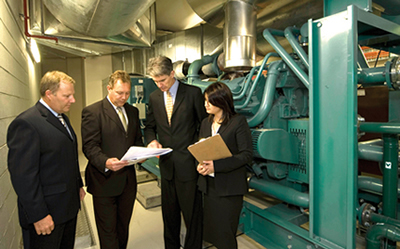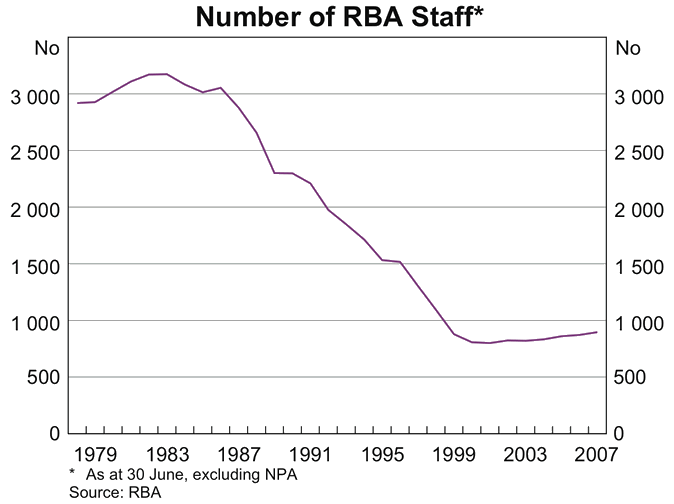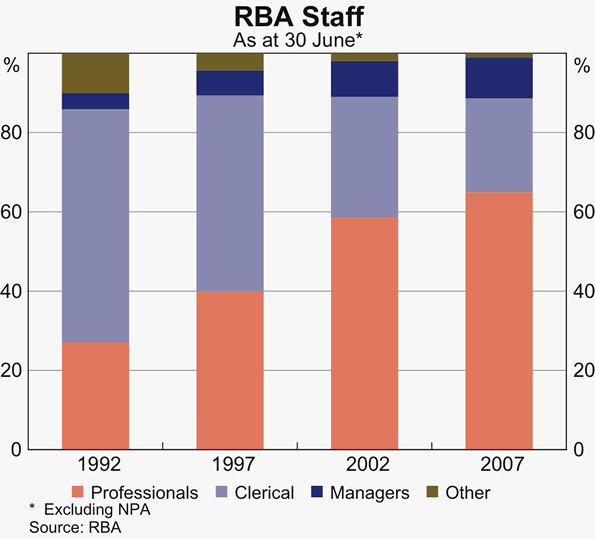Reserve Bank of Australia Annual Report – 2007 Management of the Reserve Bank
Operating Costs
The Reserve Bank requires staff and other resources to conduct its operations and meet its policy objectives. Operating costs incurred in carrying out its activities in 2006/07 amounted to about $185 million, a rise of 6.2 per cent from the previous year. Cost increases related to existing activities amounted to 5½ per cent, and new or temporary activities accounted for the remainder of the rise. These included the construction, fitting out and staffing of the new self-contained business resumption site (BRS); preparations for and co-hosting of the G-20 meeting of finance ministers and central bank governors held in Melbourne in November 2006; establishing a new data centre to strengthen the Bank's information technology (IT) systems infrastructure and contain associated risks; and development of new systems in support of economic analysis and the delivery of business services.
| 2001/02 | 2002/03 | 2003/04 | 2004/05 | 2005/06 | 2006/07 | |
|---|---|---|---|---|---|---|
| Staff costs | 73.9 | 77.8 | 85.5 | 91.4 | 101.0 | 110.2 |
| Other costs | 58.4 | 62.7 | 58.6 | 68.8 | 73.1 | 74.7 |
| Underlying operating costs | 132.3 | 140.5 | 144.1 | 160.2 | 174.1 | 184.9 |
| Cost of redundancies | 3.4 | 2.6 | 0.2 | 0.2 | 0.2 | 0.2 |
| (a) Costs associated with the ongoing operation of the Reserve Bank, excluding NPA. | ||||||
Like most other financial institutions, staff costs represent the largest single expense, accounting for around 60 per cent of total operating costs in recent years. The increase in staff costs in 2006/07 reflected a rise in base salaries of 4 per cent in November 2006, as well as some increase in staffing and the use of short‑term contractors to assist with the projects mentioned above. On actuarial advice, the Bank increased its contributions to the staff superannuation fund, restoring funding to a more normal long-term rate, after contributions had been made at significantly below the long-term norm, also on actuarial advice, for much of the previous decade.
Total employees numbered 896 at 30 June, a rise of 2.8 per cent over the year. More than half of the increase came from staffing the BRS, which became operational in mid 2007. When fully operational, this facility will employ 60 permanent staff in settlements, banking and IT. Some of these positions will be transferred from Head Office, but the new and fully operational BRS results in some increase in both staffing and costs. By providing greater certainty about the continuity of the Reserve Bank's critical systems, the BRS also strengthens Australia's financial system infrastructure. The groups responsible for monetary policy, financial market operations and financial system stability account for around half of the Reserve Bank's total operating costs. Banking, note issue and settlements each account in roughly equal measure for the remainder.


Staff numbers have tended to rise since 2001 after a period of large staff reductions. These staff reductions were associated with the loss of State government banking business in a number of the Bank's branches around Australia and the application of computer technology to the Bank's banking and registry activities. This permitted these activities to be consolidated in one location, Sydney, whereas they had previously been conducted in each of the States, and with many fewer staff. Large reductions in staff numbers also occurred with the outsourcing of tasks associated with the distribution of banknotes. The major reductions in staffing occurred in the branches.

Over time, the Bank has faced the need to put more resources into systems, leading to staff increases in the computing area, as well as higher spending on equipment. With greater reliance on IT for the delivery of services, the Bank's policy and operational areas have also required commensurately higher standards of security, availability and efficiency in these IT and communications systems. This has led to a significant addition of new staff with relevant, specialised skills.
The benefits of these developments in the Bank's IT systems are reflected in a number of its activities. The resumption of responsibility for computer operations, software development and support functions for RITS has reduced operating risks associated with the interbank settlements system and improved access to, and the efficiency of, the system itself. The Bank's systems for market operations are now fully integrated from front-office to back-office, including reporting functions, both increasing efficiency and reducing risk. Development of internet-based systems has improved the public's access to policy-related material as well as to the systems used by the Reserve Bank's banking customers. A number of systems have also been developed to assist analysis in the Bank's policy areas.
In light of their increasing call on resources, the Reserve Bank has considered from time to time the case for outsourcing some of its IT functions. It has generally decided against this approach, however, either because costs would not be significantly reduced by doing so or because outsourcing of critical systems, with the attendant diminution of control over them, would court risks that the Bank would not regard as acceptable.
Staffing
The current climate of strong expansion in the financial sector has presented more challenges for the Bank than has been the case for some time, as other financial institutions seek well‑trained, professional staff, including from the Reserve Bank. The highly competitive jobs market in financial services means that, like other financial institutions, the Bank must keep its staffing policies under continual review.
That said, the Reserve Bank has continued to recruit an adequate number of high-calibre staff from across Australia in recent years. Forty-one graduates, predominantly with honours degrees, joined the 2007 two-year Graduate Development Program, more than half from interstate. Graduates are employed in areas related to economic and financial policy, IT, accounting and law.
The professional staff now account for almost two-thirds of the Reserve Bank's employees, compared with just over a quarter a decade and a half ago. Over half of the staff hold a bachelor's degree and a fifth have post-graduate qualifications.

Financial support is provided to employees who undertake part-time study in disciplines related to their work and, in a limited number of cases, for full-time post-graduate study at universities in Australia and overseas. Almost a quarter of current staff have received financial support for study over the course of their career. There is ongoing career development and training, including management training, and secondments to other organisations. During 2006/07, staff were seconded to the BIS, Bank of England, Bank of France, Reserve Bank of New Zealand, APRA and ASIC.
The majority of staff are employed on individual contracts, which provide flexibility in awarding remuneration based on performance and market relativities. Independent consultants are engaged to ensure that remuneration policies are consistent with market practice. During the past year, the policy on providing concessional housing loans to some staff was reviewed, resulting in the cessation of further drawings on such loans by the minority of staff who still had access to them. Staff employed on individual contracts had already been ineligible for housing loan assistance for some time, as had new staff employed under the Bank's enterprise agreement since 2001. Subsidised lending to employees is no longer consistent with employing staff on remuneration comparable to market arrangements, nor is it appropriate for a central bank.
The terms of employment for the minority of staff not employed on individual contracts continue to be determined by the Reserve Bank's enterprise agreement. The agreement covering 2005 and 2006 provided for a salary increase of 4 per cent in November 2006; there was also scope for modest additional payments in recognition of good performance. Staff on individual contracts received, on average, the same salary increase in 2006/07 as those on the enterprise agreement.
Risk Management
In common with other organisations, the Reserve Bank encounters a variety of risks in carrying out its functions. The largest of these, in monetary terms, is associated with the holding of financial assets on its balance sheet and comprises exchange rate, interest rate and credit risk, but the Bank also faces significant operational and other risks.
A degree of risk is inherent in any enterprise. Risk cannot be eliminated but it can be managed. This is achieved through a process of assessment, control and monitoring. Individual managers in the various parts of the Reserve Bank are responsible for managing their own areas of risk. The Risk Management Committee ultimately oversees the management of all non-policy risks in the Reserve Bank. A centralised risk management group, the Risk Management Unit, helps areas manage their risks effectively and in a manner that is broadly consistent across the Bank, particularly where risks span more than one department, but does not itself assume those risks.
The control framework is reviewed through regular audits of the Reserve Bank's operations. The Bank has an independent internal audit function and the Audit Committee reports directly to the Reserve Bank Board.
Operational Risk
Balance sheet risks are managed by Financial Markets Group, as set out in the section on Risk Management in the chapter on Operations in Financial Markets. Operational risks of various kinds arise throughout the Reserve Bank, but the largest results from the Bank's operations in financial markets and its provision of banking and settlement services to clients and the market. In 2006/07, the Reserve Bank undertook around 95,000 transactions in global financial markets, with average daily settlement flows of around $37 billion. As the main banker for a number of government agencies, the Reserve Bank processes about 280 million transactions a year, including all Australian Taxation Office, Medicare Australia and Centrelink payments. It also provides real-time interbank payment and settlement services through RITS, which typically involves processing around 27,000 payment instructions per day, for an average daily value of $170 billion.
The types of risk that can arise in these operations include the risk of unauthorised or fraudulent transactions by staff, mishandling sensitive information, process errors, system errors or business interruptions due to disasters. While these risks can give rise to financial loss, equally important for a central bank is the potential damage to the organisation's reputation.
Controls in place to manage operational risk include a clear decision-making hierarchy, detailed procedures manuals, embedded controls in computer systems to prevent unauthorised transactions and enforce limits, back-up systems, and separation of duties in particular areas. Programs have been initiated to heighten staff awareness about their legal and statutory responsibilities as employees of the Reserve Bank. During the past year, most staff completed a formal training program to enhance awareness of the potential for fraudulent behaviour in all parts of the Bank, as well as the relevant controls and procedures that are in place to deal with it. The Code of Conduct, with which staff are expected to comply, is reviewed from time to time to ensure it remains contemporary and relevant.
Disaster recovery and business continuity arrangements were strengthened by the completion of the Reserve Bank's BRS, which enhances the Bank's ability to maintain its critical functions – including RITS, banking operations and operations in financial markets – if access to Head Office systems or accommodation is lost. This project strengthens the financial system infrastructure in Australia, and is in line with steps being taken by banks and central banks around the world to cope with disruptions to their activities.
Finally, the Bank continued to develop its response to the key issues that might arise if an avian flu pandemic were to occur in Australia or overseas. While initiated in response to the threat posed by avian flu, much of the work that has been undertaken to date has been beneficial for business continuity planning in the event of a major disruption to the Bank's operations from any source. Some of the changes brought about by this work have also introduced efficiency gains for the Bank's regular operations, such as an enhanced capacity for Reserve Bank staff to work on a remote basis.
Facilities Management
The Reserve Bank owns and manages its premises where there is a business need. Current property assets in Australia are: in Sydney, the Head Office building, the HC Coombs Centre for Financial Studies and the BRS; the Melbourne and Canberra offices; and the Craigieburn site north of Melbourne, where Note Printing Australia, the National Note Processing and Distribution Centre and Securency are located. Any surplus space in these buildings is leased to external tenants on commercial terms; the gross annual income from these leases amounted to $6.5 million in 2006/07. In other locations, the Bank leases office space as required, such as for the Regional Offices in Adelaide, Brisbane and Perth.
Major steps were taken in 2006/07 to strengthen both the resilience and security of facilities used for critical operations. In February 2007, the BRS reached practical completion, following a 13‑month construction period. The project was completed ahead of schedule and well within the approved budget. During the year, the data centre at Head Office was also modernised. This strengthened the delivery of power and communications infrastructure and generally improved its resilience.
Following an extensive risk-assessment process, a major upgrade of the Head Office electrical infrastructure commenced during the year. The upgrade involves replacing the main switchboard, which has been in place since the mid 1960s, and associated electrical infrastructure, and improving system redundancy; the construction phase began in April 2007 and is due to be completed in early 2008.
Since 1992/93, the Reserve Bank has achieved overall reductions in energy intensity (consumption per unit of occupied area) averaging 2.5 per cent per annum. During the year, an energy audit of the Head Office building was completed, which identified a range of further improvements, some of which have been implemented while others are currently subject to investigation. Additionally, ‘green power’ was purchased for about 10 per cent of the Bank's needs in NSW and the ACT as part of new electricity supply arrangements. During the year, the Reserve Bank's environmental initiatives also included several pilot programs focusing on office waste recycling. These pilot programs have achieved reductions in paper consumption and fuel consumption for pool motor vehicles of 6 per cent and 17.5 per cent, respectively.
The BRS has been designed to achieve a 4.5 star Australian Building Greenhouse Rating, including such features as rainwater harvesting and high energy-efficiency in the lighting, air-conditioning, facade and roof systems.
Consultancies
The Reserve Bank employs outside contractors or professional service providers to carry out specific tasks where necessary, and also, from time to time, uses consultants. A consultant investigates particular issues and then provides independent advice. In 2006/07, the following four consultancies were undertaken in Australia.
| Name | Project | Cost ($, excl. GST) |
Purpose |
|---|---|---|---|
| Edgar Dunn & Co. | Study of costs of different payment methods | 30,345 | Advice on the design of the study on payment costs |
| Australian Government Solicitor |
Management of crises in the financial system | 16,110 | RBA share of legal advice provided to CFR |
| Mallesons Stephen Jaques | Mainframe computer | 27,997 | Legal advice on proposed licensing arrangements for mainframe software |
| Hay Group Pty Ltd | RBA personnel | 54,545 | Market testing of remuneration of RBA staff |
| (a) Costing $10,000 or more. | |||